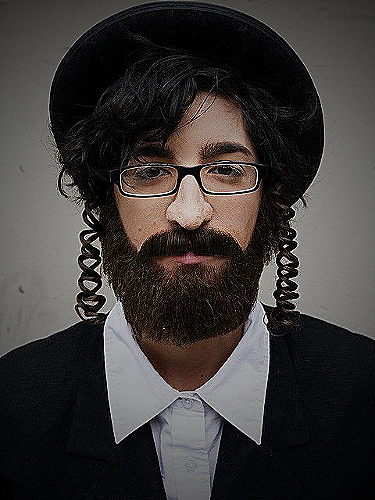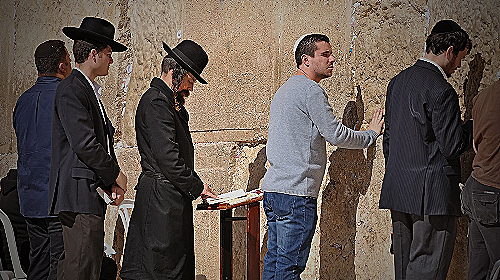Have you ever wondered why Jewish men have curls on the sides of their heads? This unique hairstyle is known as payot, and it holds great religious and cultural significance for many Jewish communities, particularly the Orthodox and Hasidic.
In this article, we will explore the history and meaning behind this hairstyle and how it relates to Jewish beliefs and practices.
Do you ever wonder why some Jewish men have curly side locks? Check out this Youtube video, “What Are Those Curly Side Locks That Some Jewish Men…” to learn about the significance behind this unique Jewish tradition.
If you’re curious about different cultures and traditions, this video is a must-watch. Gain some new knowledge and perspective by checking out this informative video on why Jewish men have curls.
The Significance of Payot in Jewish Culture
In Jewish culture, Payot holds significant importance due to the religious scriptures that dictate their use. The practice of Payot involves growing out the hair on the sides of the head and letting them curl.
This practice is based on an interpretation of the Tanakh, which forbids shaving the “sides” of one’s head. The literal meaning of Payot is “corner, side, edge” and is believed to be a commandment from God to Jewish men to refrain from shaving these areas.
Payot is primarily observed by Haredi or Hasidic, Yemenite, and Chardal Jews. There are different styles of Payot that vary according to the community and the interpretation of the religious scriptures.
Growing Payot is considered a symbol of spiritual commitment and devotion to God. It is believed to be a way of separating oneself from the secular world and purifying oneself from sin.
Moreover, Payot reflects the value of modesty and humility in Jewish culture. It is believed that the side curls cover the ears and prevent one from hearing evil speech or other indecent sounds.
Payot is also seen as a way of preserving traditional clothing and grooming practices that have been passed down from generation to generation.

Payot: Types and Styles
Payot are religious side curls worn by some Orthodox Jewish men and boys. The word “payot” literally means “corner, side, edge” in Hebrew, and it is based on an interpretation of the Tanakh’s injunction against shaving the “sides” of one’s head.
Payot vary in length ranging from just above the ear to below the collarbone.
There are different styles of payot among different Jewish communities such as Hasidic, Yemenite, and Chardal Jews. The Hasidic Jews wear long payot that are often curled or twisted, while the Yemenite Jews have noticeably short payot.
Chardal Jews commonly wear payot that blend into their hair and appear less distinct.

The Connection between Payot and Beards
Jewish men are often seen sporting both Payot and Beards, but what is the meaning behind this? Payot is the Hebrew word for sidelocks and refers to the hair that curls down beside the ears.
The practice comes from an interpretation of the Tanakh where it says, “You shall not round off the pe’at of your head.” This injunction is understood to mean that the hair on the side of the head must not be cut, but rather grown long and curled, hence the sidelocks.
Hasidic Jewish men, in particular, tend to wear sidecurls or Payot, usually in front of each ear and extending downwards. They can be long and often curly.
Some payot styles vary among different groups in the Orthodox Jewish community, like Haredi, Yemenite, and Chardal Jews. Yemenite Jews call their sidelocks “simanim”, which means “signs” in Hebrew.
Sidelocks served as a distinguishing feature in Yemenite society, differentiating them from their non-Jewish neighbors.
On the other hand, Hasidic Jewish men also usually wear a beard. The connection between the two is mainly religious.
Payot and beards are both related to spiritual beliefs and observances. The beard is a symbol of masculinity and authority, while sidelocks are a reminder of the commandment to keep the hair on the side of the head uncut.
Wearing both is simply a way for Jewish men to observe their faith and customs.
In conclusion, Payot and beards are worn by Jewish men for religious reasons. The sidelocks come from an interpretation of the Tanakh, while the beard is a symbol of masculinity and authority.
Wearing both the Payot and beard is a way for Jewish men to observe their faith and customs.
Why Can’t Jewish Men Use Razors?
In the Jewish religion, there is a law prohibiting the use of razors on certain parts of the body, such as the beard and sidelocks. This law is based on a rabbinic interpretation of Leviticus 19:27, which states, “Ye shall not round the corners of your heads, neither shalt thou mar the corners of thy beard.”
The Jewish law against using razors is often associated with the growth of Payot and beards among Jewish men. Payot, also known as sidelocks or sidecurls, are worn by some men and boys in the Orthodox Jewish community based on an interpretation of the Tanakh’s injunction against shaving the “sides” of one’s head.
Literally, pe’a means “corner, side, edge”.
There are different styles of Payot among Haredi, Hasidic, Yemenite, and Chardal Jews. Hasidic Jewish men typically wear sidecurls and a beard.
The sidecurls – called “Payos” – are usually in front of each ear, extending downwards. They can be long and often curly.
Yemenite Jews call their sidelocks simanim ( סִימָנִים), literally, “signs”, because their long-curled sidelocks served as a distinguishing feature in the Yemenite society, differentiating them from their non-Jewish neighbors.
The Jewish law against using razors has contributed to the growth of beards among Jewish men. Many Jewish men grow beards as a sign of their faith and as a symbol of their commitment to God.
By not shaving, they are fulfilling the commandments of the Jewish religion.
Other Jewish Hair Customs
Judaism has several other hair customs that are significant in the Jewish community. For instance, Orthodox women cover their hair in public after they get married.
This is done through a headscarf or a wig called a sheitel in Yiddish to convey their marital status and comply with traditional standards of decency. On the other hand, men in the Orthodox Jewish community wear Payot, which are long, curled sidelocks that hang in front of each ear and extend downwards.
This practice is based on a Tanakh injunction that advises against shaving the “sides” of one’s hair. It is interpreted to mean that a man should let his hair grow and dress it in long sidelocks, also known as Pe’a.
Payot come in various styles and are worn by Haredi, Hasidic, Yemenite, and Chardal Jews. Yemenite Jews, for example, refer to their sidelocks as “Simanim,” which means “signs” in Hebrew.
Understanding the Traditional Jewish Male Appearance
Jewish men have been embracing distinctive styles and symbols in their traditional appearance, including head coverings, garments, and accessories. One of the commonly recognized features of Jewish male appearance is the sidecurls, called “Payot” in Hebrew.
These curls are worn by some Orthodox Jewish men and boys and serve as a sign of their faith and commitment to their religion.
The origin of Payot dates back to the Hebrew Bible, where Leviticus 19:27 states, “Ye shall not round the corners of your heads, neither shalt thou mar the corners of thy beard.” The Talmudic interpretation of this passage prohibited using a razor on the beard, giving rise to different interpretations of what constitutes a beard.
In some Orthodox communities, this interpretation includes sidecurls as a symbol of being faithful to God.
There are different types of Payot among Haredi or Hasidic Jewish communities, such as the Yemenite Jews who call their sidelocks “Simanim” (signs) and the Chardal Jews. The length and curliness of the payot vary from community to community and reflect their religious beliefs and historical traditions.
Aside from the Payot, Hasidic Jewish men also typically wear a beard. The beard serves as a symbol of wisdom, maturity, and dignity in Jewish tradition.
Jewish male dress also includes traditional garments, such as the kippah or yarmulke, a brimless cap worn on the head as a sign of respect and reverence to God. They also wear tzitzit, a fringed undergarment with knotted tassels that symbolize the commandments of God.
In Orthodox Jewish communities, the attire reflects the importance and holiness of their faith, as well as their adherence to religious customs and beliefs.
FAQs About Jewish Men and their Curls
What is the meaning behind the curls worn by Jewish men?
Do all Jewish men have curls?
What is the history behind Jewish male appearance?
Conclusion
The curls worn by Jewish men, called payot or simanim, hold significance in Jewish culture and beliefs, particularly among the Haredi, Hasidic, Yemenite, and Chardal communities. These curls are based on an interpretation of the Biblical scripture that prohibits shaving with a razor on the beard and rounding the corners of one’s head.
Ultra-Orthodox men observe hair cutting restrictions as part of their religious practice and identity, and the curls serve as a distinguishing feature among their communities. Orthodox Jewish women also observe modesty practices by covering their hair in public, either with a headscarf or wig.
References
Here are some resources that provide additional information on “why do Jewish men have curls”:
